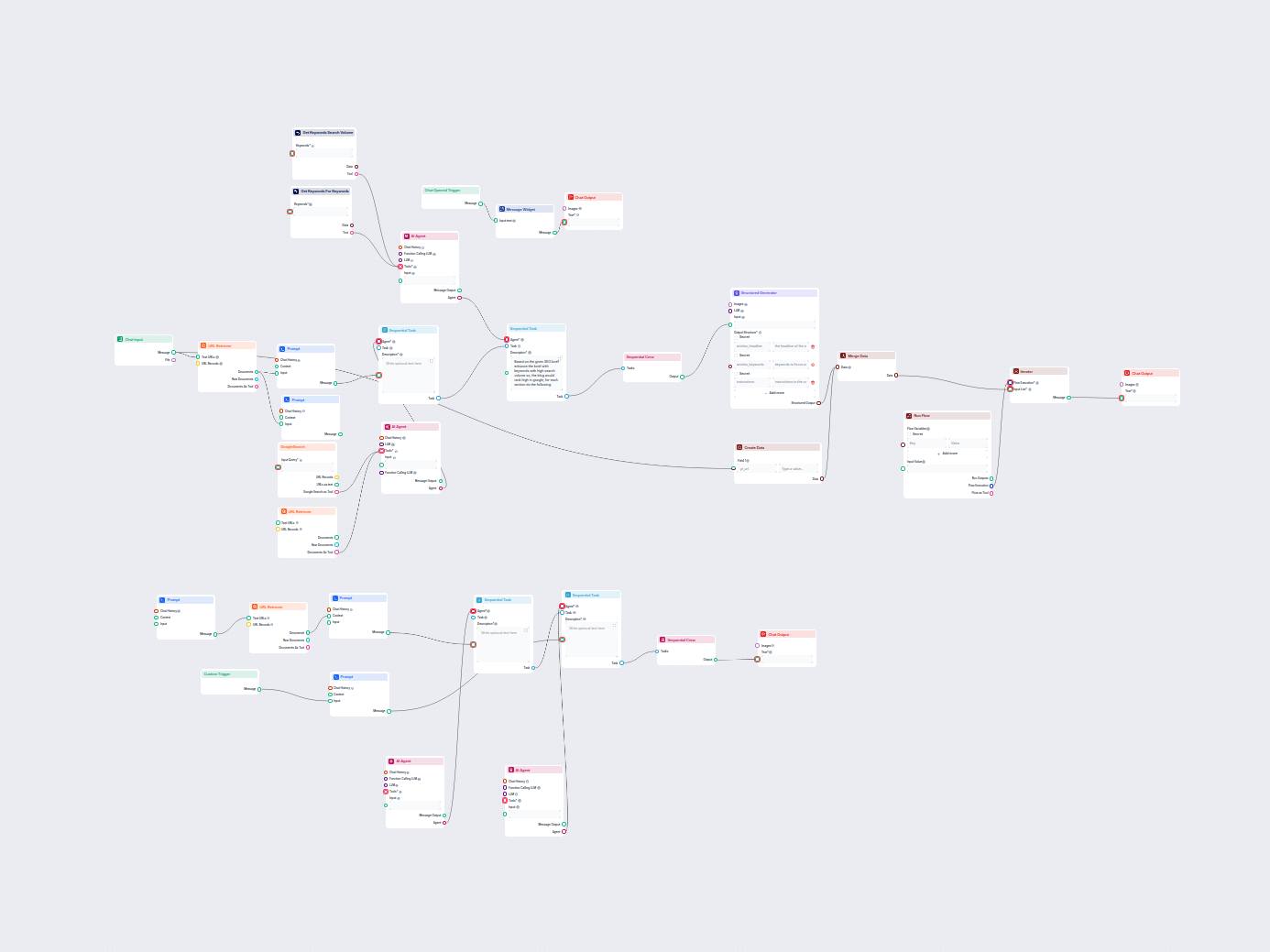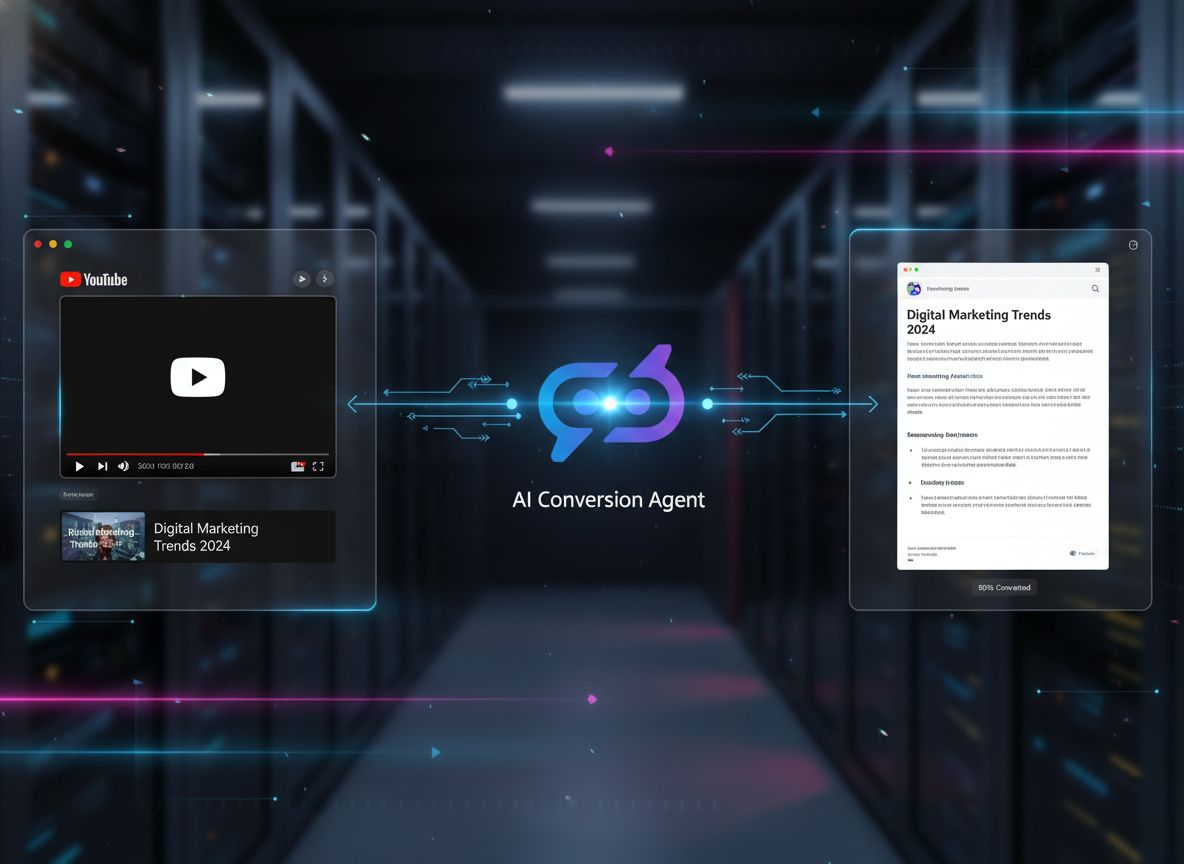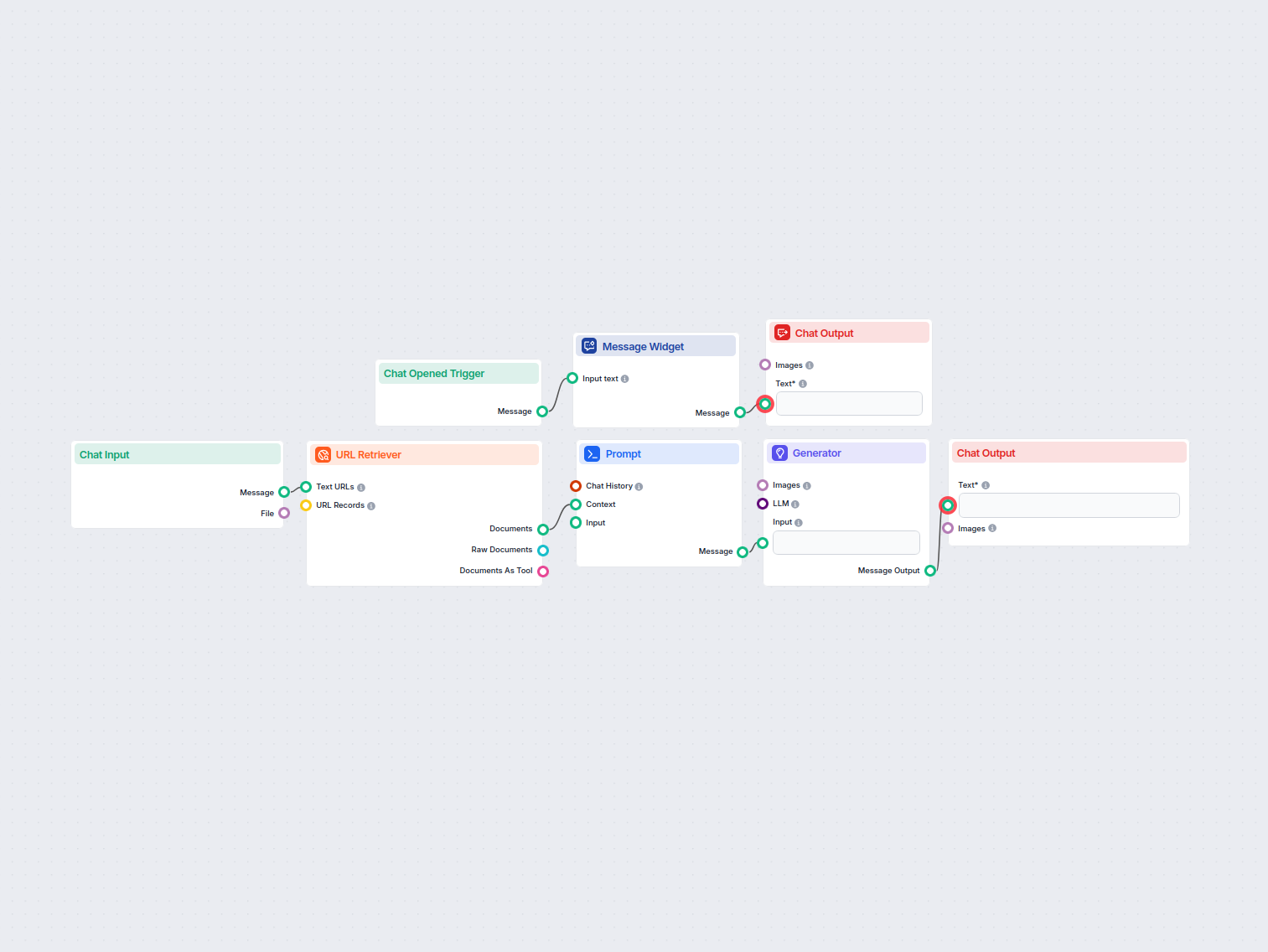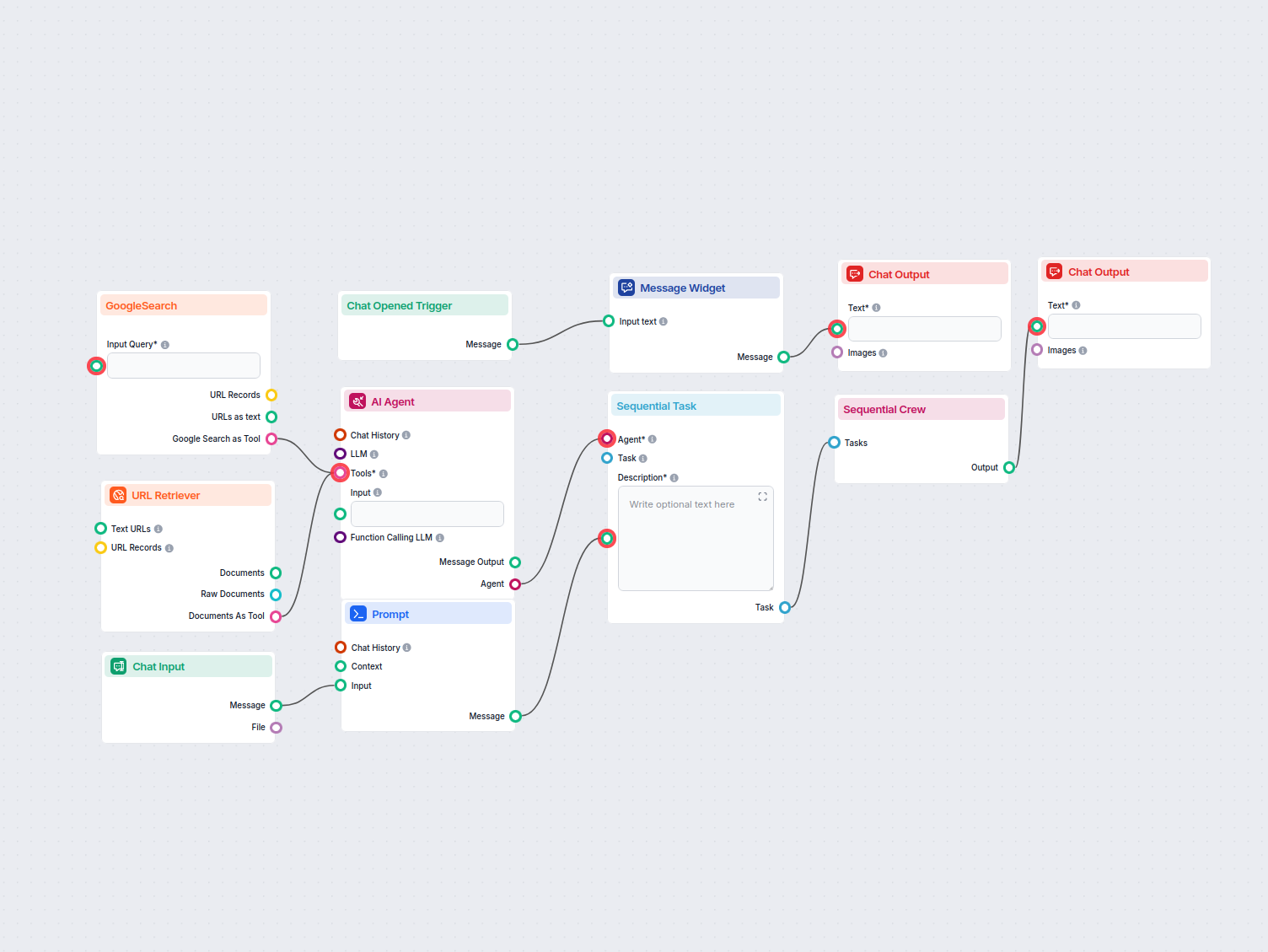Prompt: Generate Blog Brief from YouTube Transcript
Prompt to generate a brief that discusses each section based on a YouTube transcript of the podcast 'AI Over Coffee'.
Automatically generate high-ranking SEO blog posts from YouTube videos. This workflow extracts video transcripts, analyzes top SEO keywords, creates a detailed blog outline, and writes engaging blog content optimized for Google search.

Flows
Prompt to generate a brief that discusses each section based on a YouTube transcript of the podcast 'AI Over Coffee'.
Prompt to write a full blog copy (2500 words) from the SEO brief and YouTube transcript, with specific instructions to avoid generic phrases and focus on main i...
Prompt for summarizing a YouTube transcript to write a specific section of a blog, focusing on headline, keywords, and instructions.
Prompt to write the copy for a section of a blog, using a summary and instructions, focusing on keywords and including the section headline in H2 markdown.
Prompt template to pass the YouTube URL as a variable for downstream components.
Below is a complete list of all components used in this flow to achieve its functionality. Components are the building blocks of every AI Flow. They allow you to create complex interactions and automate tasks by connecting various functionalities. Each component serves a specific purpose, such as handling user input, processing data, or integrating with external services.
The Chat Input component in FlowHunt initiates user interactions by capturing messages from the Playground. It serves as the starting point for flows, enabling the workflow to process both text and file-based inputs.
Unlock web content in your workflows with the URL Retriever component. Effortlessly extract and process the text and metadata from any list of URLs—including web articles, documents, and more. Supports advanced options like OCR for images, selective metadata extraction, and customizable caching, making it ideal for building knowledge-rich AI flows and automations.
Learn how FlowHunt's Prompt component lets you define your AI bot’s role and behavior, ensuring relevant, personalized responses. Customize prompts and templates for effective, context-aware chatbot flows.
The AI Agent component in FlowHunt empowers your workflows with autonomous decision-making and tool-using capabilities. It leverages large language models and connects to various tools to solve tasks, follow goals, and provide intelligent responses. Ideal for building advanced automations and interactive AI solutions.
FlowHunt's GoogleSearch component enhances chatbot accuracy using Retrieval-Augmented Generation (RAG) to access up-to-date knowledge from Google. Control results with options like language, country, and query prefixes for precise and relevant outputs.
Unlock keyword insights with the Google Search Volume component—analyze search volume, competition, and trends for keywords across locations and time ranges. Ideal for marketers, SEO specialists, and anyone looking to optimize content based on real search data.
Unlock valuable keyword insights with the Google Keywords Finder component—automate the discovery of related keywords, search volume trends, competition, and cost-per-click data. Perfect for building flows that need real-time keyword research and SEO optimization capabilities.
The Sequential Task component organizes workflow steps by defining a clear task description, expected output, and assigning an agent to execute the task. Ideal for structured, multi-step processes, it ensures each step is well-documented and assigned, supporting complex automations in FlowHunt.
The Structured Output Generator component lets you create precise, structured data from any input prompt using your chosen LLM model. Define the exact data fields and output format you want, ensuring consistent and reliable responses for advanced AI workflows.
Combine multiple data sources effortlessly with the Merge Data component in FlowHunt. This versatile block collects and merges input data, streamlining workflows that require unified information handling.
The Create Data component enables you to dynamically generate structured data records with a customizable number of fields. Ideal for workflows that require the creation of new data objects on the fly, it supports flexible field configuration and seamless integration with other automation steps.
Experience organized workflow automation with the Sequential Crew component in FlowHunt. This component allows you to group multiple agent tasks and execute them one after another, making it ideal for processes that require clear, step-by-step task processing.
The Iterator component in FlowHunt automates repetitive tasks by executing a subflow or external flow for each item in a list. Ideal for batch processing, data enrichment, or applying the same logic to multiple inputs, it supports customizable concurrency and advanced options for flexible workflow automation.
The Run Flow component in FlowHunt lets you trigger and execute another workflow within your current flow. Pass inputs, variables, and control how flows interact, enabling modular and reusable automation. Ideal for chaining workflows or using flows as tools.
Discover the Chat Output component in FlowHunt—finalize chatbot responses with flexible, multi-part outputs. Essential for seamless flow completion and creating advanced, interactive AI chatbots.
The Message Widget component displays custom messages within your workflow. Ideal for welcoming users, providing instructions, or showing any important information, it supports Markdown formatting and can be set to appear only once per session.
Unlock custom workflows with the Custom Trigger component in FlowHunt. This component allows users to define specific trigger points within their flow, enabling tailored actions based on custom events or inputs. Essential for building interactive and flexible automation workflows.
Flow description
The Youtube Blog Generator is an advanced automated workflow designed to transform YouTube videos—specifically podcasts—into high-quality, SEO-optimized blog posts. It leverages AI agents, SEO tools, and content structuring mechanisms to automate the entire content creation process from video URL input to finalized blog sections ready for publishing.
The workflow automates the following core steps:
This enables you to scale blog production from YouTube content with minimal manual intervention while ensuring each post is optimized for search visibility.
| Component | Purpose |
|---|---|
| Chat Input/Output | Receives video URL from user and displays results. |
| Message Widget | Welcomes user and guides them through the process. |
| URL Retriever | Extracts transcript/content from the YouTube video. |
| Google Search/Keyword Tools | Performs SEO research to identify best keywords and topics. |
| AI Agents | Specialized personas for SEO brief creation, summarization, and copywriting. |
| Prompt Templates | Guide AI agents in structuring briefs, summaries, and blog copy. |
| Structured Output Generator | Formats and organizes the blog sections. |
| Sequential Tasks & Crew | Manage the order and execution of various tasks (briefing, summarizing, writing). |
| Iterator | Processes each blog section individually, enabling scalability and modularity. |
| Merge Data | Aggregates section outputs into one final blog post. |
By automating these steps, the Youtube Blog Generator provides an end-to-end solution for repurposing video content into high-impact, SEO-optimized written material—saving time, improving quality, and boosting search visibility.
We help companies like yours to develop smart chatbots, MCP Servers, AI tools or other types of AI automation to replace human in repetitive tasks in your organization.
Learn how to automatically convert YouTube videos into SEO-optimized blog posts using AI agents, FlowHunt, and intelligent workflow automation. Discover the com...
Automatically turn any YouTube video transcript into SEO-friendly web page content. Enter a YouTube URL and get a fully structured web page draft, complete with...
Generate an SEO-friendly content brief outline by analyzing top-ranking Google search results for a given keyword. This workflow uses AI and web search tools to...
Cookie Consent
We use cookies to enhance your browsing experience and analyze our traffic. See our privacy policy.



